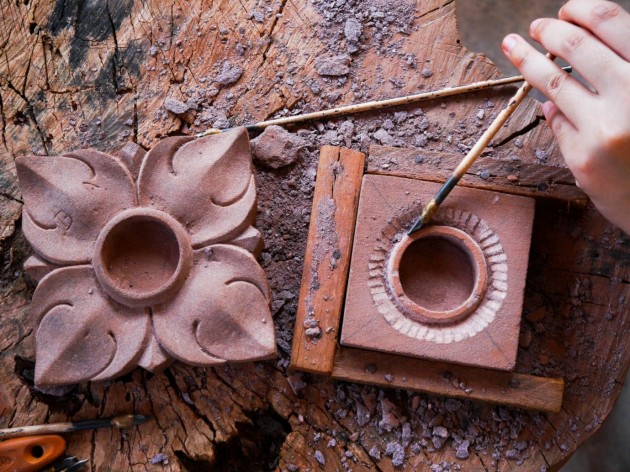Carving A Piece Of Cambodia
“Clink, clink, clink”. Every strike of the hammer sends my chisel plunging into sandstone, dislodging tiny chunks which scatter haphazardly across the table. A tingly ache creeps up behind my hunched-over back while dripping beads of perspiration from my forehead dissolve into damp speckles on the red, earthy surface of the stone block.
It is Sunday afternoon, and I am learning the traditional Cambodian art of stone carving in the modest workshop of 31-year-old Poy Khet, a professional craftsman. An hour into incessantly chipping away at a square slab, an exquisite Romdoul flower – the national flower of Cambodia – is taking shape.
“One by one, not too strong,” says Khet as he watches me struggle to control the strength exerted from my hammer. Carving the delicate contours of the flower’s petals proves to be the most difficult task for the day, and Khet soon takes over from my clumsy strikes and awkward balancing. Like knife slicing through a milky butter slab, the instrument weaves seamlessly in and out of the most narrow corners of the stone under Khet’s skilful hands.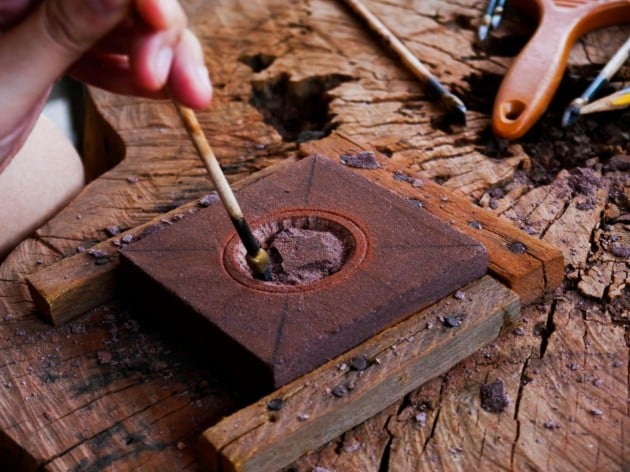 Using a chisel to carve a slab of sandstone into a Romdoul flower candle holder at a stone carving workshop in Siem Reap. Photo by: Manesha Pereira
Using a chisel to carve a slab of sandstone into a Romdoul flower candle holder at a stone carving workshop in Siem Reap. Photo by: Manesha Pereira
Miniscule stone flakes drift off freely into the wind, like a cloud of colliding particles caught in a dust storm. It is a hypnotizing spectacle of magic; within seconds the intricately curved outline of the flower’s teardrop-shaped petals emerge into view.
Stone Sculptures Everywhere
In Cambodia, Khmer stone sculptures are found everywhere – lined along the unpaved roads, hidden in obscure corners of grubby places, nestled within lush greenery of forest wilderness, or hawked as valuable wares in thriving marketplaces. A stone deity stands right smack in the middle of a bustling traffic junction in Phnom Penh. With eyes shut and hands in a meditative position, she cuts an imperturbable figure of serenity as vehicles around her whir by.
Over in Siem Reap, two white, glorious lion stone sculptures with manes perch proudly along a sparse and dusty sidewalk. They stare forbiddingly into the distance, the striking richness of their detail incongruous with their comparatively under-developed environment.
Peppered all over the land, these distinctive stone sculptures are the humans of Cambodia – upright, impregnable and unscathed by the constant flux of the city.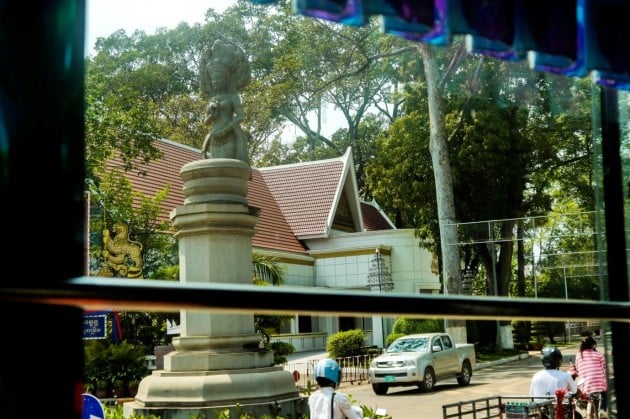 A stone deity stands in the middle of a bustling traffic junction in Phnom Penh.
A stone deity stands in the middle of a bustling traffic junction in Phnom Penh.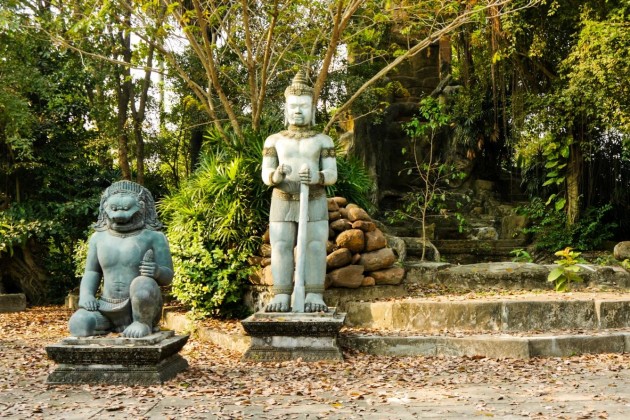 Two Khmer statues nestled deep within the forest.
Two Khmer statues nestled deep within the forest.
The Stone Carvings of Angkor Wat
But it is in the splendorous Angkor Wat, the first stop of my temple tour, where the most magnificent stone carvings can be found. Constructed entirely from sandstone, Angkor Wat’s grand Khmer architecture is a sight to behold even from a distance.
It is impossible to miss the pointed peaks of the temple’s iconic lotus bud towers thrusting into the sky, bearing down upon the milling tourist masses like a watchful tyrant overlooking his kingdom.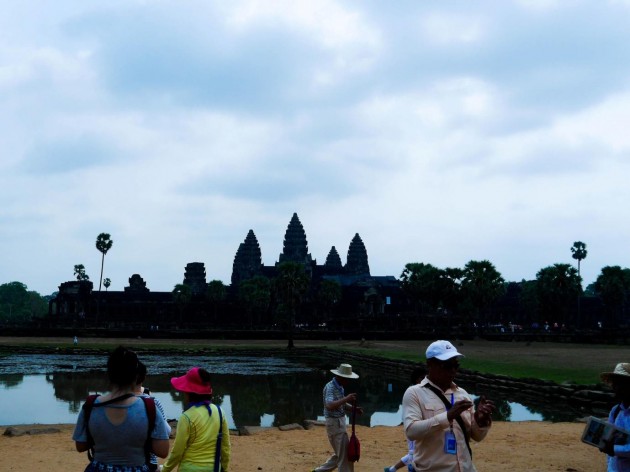 Angkor Wat, the crown jewel of Cambodia’s many Angkorian temples. Photo by: Manesha Pereira
Angkor Wat, the crown jewel of Cambodia’s many Angkorian temples. Photo by: Manesha Pereira
Almost every part of Angkor Wat is emblazoned with intricate carvings steeped in Hindu and Buddhist mythology, from its meandering walkways to its tall doors, thick pillars and ceilings.
There are murals depicting goddesses and monkey gods and demons waged in war, all riddled in the most convoluted detail. They are met by towering sculptures like the symbolic Buddha naga (an enlightened Buddha is seated on the coils of a giant cobra) – each stone carving has a fascinating story to tell of Cambodian history and legend.
Engraved into every nook and cranny of the temple’s rugged walls are bevies of bare-breasted dancing nymphs, heads enshrined with sophisticated headgear and bodies clad with only a limp sarong. “These are Apsaras,” my guide Thoeun Bunthy tells me. In Hindu legend, Apsaras would dance to music created by their husbands the Ghandarvas, who served as court musicians in the palace of gods.
Over 1,800 stone carvings of these celestial and divine female beings line the exterior and interior of Angkor Wat, their arms contorted in an array of lithe positions, poised to break out into graceful dance.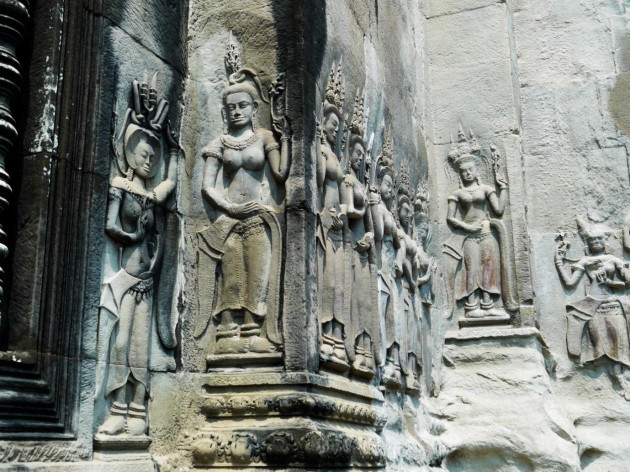 Over 1,800 stone carvings of dancing Apsaras can be found in Angkor Wat. Photo by: Manesha Pereira
Over 1,800 stone carvings of dancing Apsaras can be found in Angkor Wat. Photo by: Manesha Pereira
The long sandstone causeway that leads to the main temple is marked by prominent bleached and faded boulders. Weathered by rain and nature over the years, they barely show the original carving pattern of dragons inscribed, now reduced instead to a strange patchwork of barely-there serpentine swirls and holes.
Yet you can still faintly make out the unmistakable arch of a dragon’s supple body, the warmth from the stone surface almost like the emission of fiery heat from the core of the creature’s breath. Perhaps that is the beauty of stone carving: its impermanent ability to withstand the onslaught of time, telling a story through solid stone – once a mark is made, it never goes away.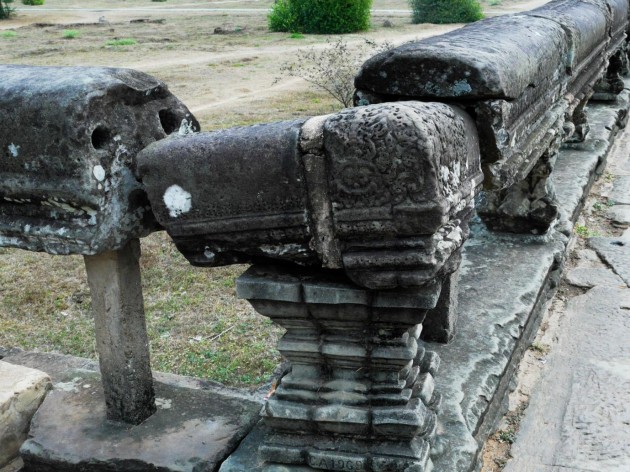 The faded boulders lining the long sandstone causeway at Angkor Wat. Photo by: Manesha Pereira
The faded boulders lining the long sandstone causeway at Angkor Wat. Photo by: Manesha Pereira
Stone Carving Now And Then
The art of stone carving has been around since time immemorial, having flourished since the foundation of the Khmer nation. Over 300 stone temples were constructed during the 9th and 12th centuries of the Khmer Empire – the golden age of stone carving – in the bustling metropolis of Angkor, with colossal sandstone blocks transported to temple sites by a series of long canals.
But the decline of traditional and modern arts began later in the 20th century during the rule of Pol Pot from 1975 to 1979. An estimated 90 per cent of the population’s skilled and educated artists were slaughtered, save the remaining few who fled abroad.
However, extensive efforts by the government, non-governmental organizations and social businesses have ensured the artistic revival of the traditional Cambodian arts scene. Demand for stone sculptors and carvers has been brought about by the need to restore historical pieces in the temples, ensuring that these ancient skills live on in the new generation.
Along a dark and secluded corridor in a tower, a row of headless grey statues settle lonesomely on thick pedestals. With the jarring absence of their heads, they cast shadows against the walls forlornly as warm sunlight streaming in through the windows illuminates their nondescript pockmarked bodies.
To the average tourist on first sight, these elusive statues bear little semblance of any individuality or identity, but I soon learn from Bunthy that they are Buddha sculptures which were beheaded during the Khmer Rouge.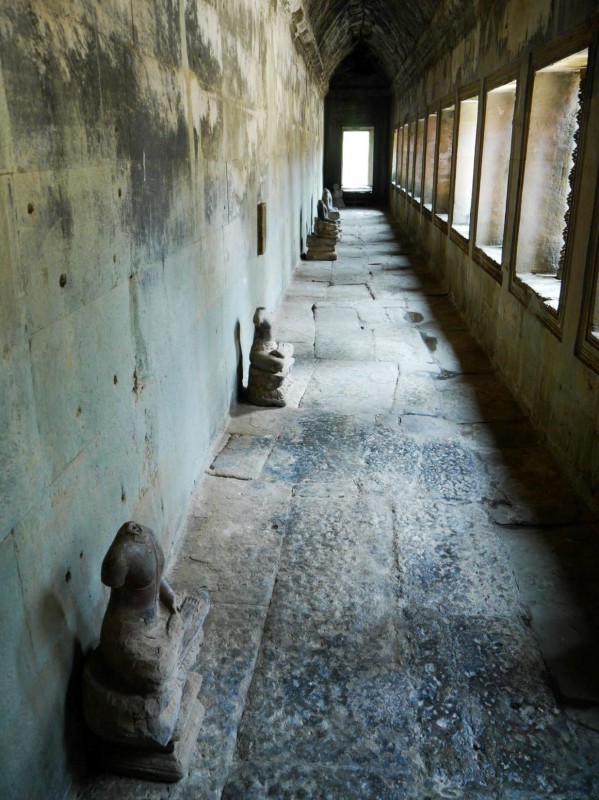 Beheaded Buddha statues in Angkor Wat.
Beheaded Buddha statues in Angkor Wat.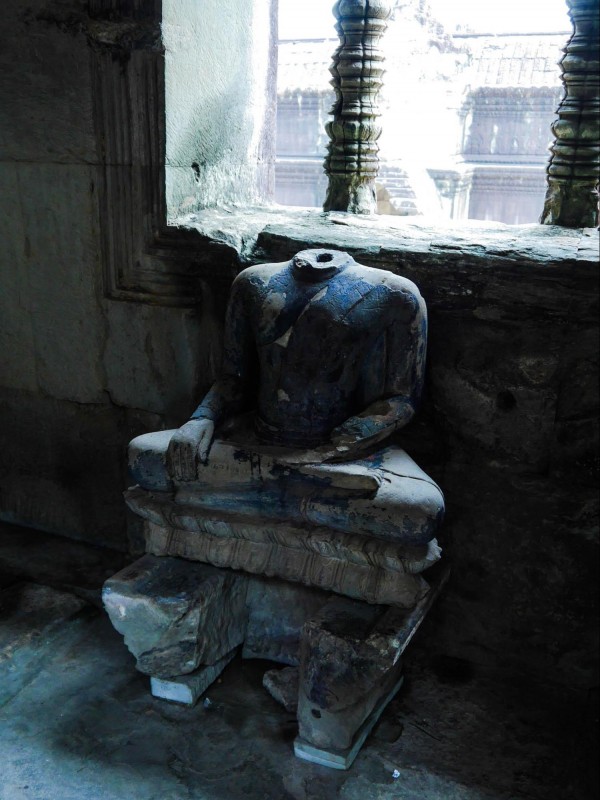 Beheaded Buddha statues in Angkor Wat.
Beheaded Buddha statues in Angkor Wat.
In 1979, the Khmer Rouge tried to completely obliterate Buddhism, killing monks and religious intellectuals, and destroying Buddhist institutions. Any representations of the Buddha were desecrated; soldiers ravaged the vicinities of temples and cut off the heads of Buddha sculptures to sell them in the black market. “Too expensive to restore. They want to keep history,” says Bunthy, pointing to a jagged indent left in the wake of a dismembered stone neck.
With the revival of Buddhism in Cambodia over the years, now the official religion of the country, these preserved decapitated artefacts are potent remembrances of Cambodia’s previously tumultuous political landscape. Yet despite the deliberate acts of destruction, they sit defiantly in the temple, their solid postures almost a taunt to those who tried to rob them of their existence.
Back At The Workshop
Back in the stone carving workshop, for a moment my mind wanders off. And that is when it happens: I accidentally chip away a corner of stone with the chisel, leaving a petal with an unsightly dint in the corner. My heart sinks and I cry out in dismay. But Khet comforts me as he takes the chisel from my hands.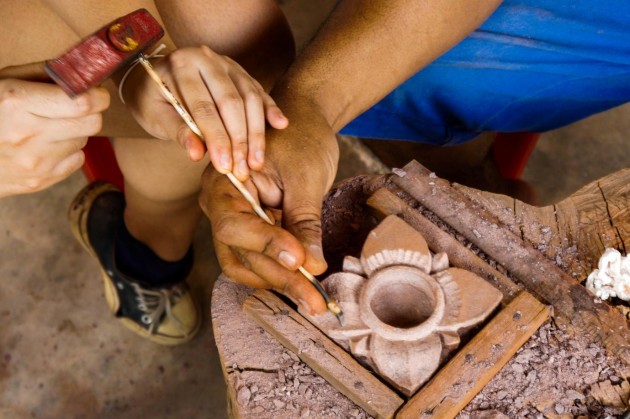 Khet helps me hold my chisel steady in place. Photo by: Manesha Pereira
Khet helps me hold my chisel steady in place. Photo by: Manesha Pereira
He manoeuvres the instrument with deft precision and ease, intensely scraping around the sides to even out the rough chip. Reminiscent of a skilled surgeon in an operating theatre, his level of focus is astounding, never once stopping to look up until the edge of the dint has been completely smoothed. “When I work, I don’t see anyone who walks by. I see stone only,” says Khet, who has been carving for 17 years.
Immediately I think back to the myriad of chiselled bas-reliefs all over Angkor Wat. An immense admiration for the countless craftsmen who laboured over these carvings during the Khmer Empire washes over me. What little luxury they had falling into careless daydream, when constructing the majestic architecture of Angkor leaves little room for mistake.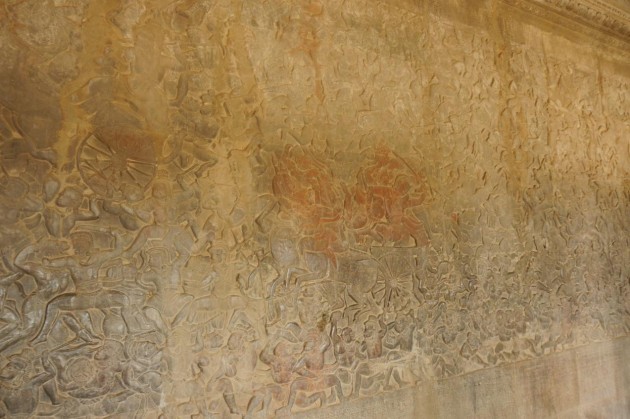 Intricately carved bas-reliefs at Angkor Wat.
Intricately carved bas-reliefs at Angkor Wat.
The stone-carving business has been running in Khet’s family for three generations – his grandparents and parents were in the stone-carving business, and Khet himself owns his own shop selling stone carvings. He tells me how as a teenager, he would spend hours after school every day honing his craft from his elder brother, a masterful stone carver.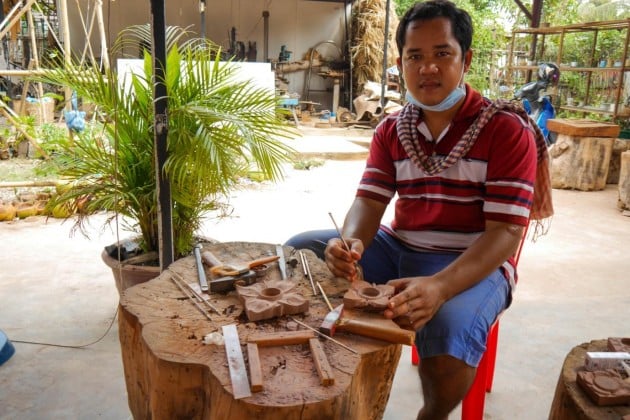 Poy Khet, 31, has been a professional wood and stone carver for 17 years. He teaches the stone-carving workshop for tourists under Backstreet Academy in Siem Reap.
Poy Khet, 31, has been a professional wood and stone carver for 17 years. He teaches the stone-carving workshop for tourists under Backstreet Academy in Siem Reap.
After so many years of being in the trade, it is still the immense pride for his country’s architectural achievements that keeps his love for stone carving going. “It is my skill, and I want to continue the Khmer culture. Just like the people who make all the temples, I want to do the same thing as them,” he says softly.
The Smiling Faces of Bayon Temple
After Angkor Wat, I visit Bayon Temple in the late evening, renowned for its 216 charmingly smiling stone faces of the Bodhisattva Avalokiteshvara carved into every side of its 54 towers. Each massive face projects a serene display of absolute composure, as though nothing could possibly disrupt their sublimely tranquil state of being. “The gods smile for the people, so the people can live in peace and happiness,” explains Bunthy, pointing towards the sky.
As I stare up at their comfortingly upward curved lips and closed, thick eyelids, for a moment I understand what he means. Wherever I roam in the temple, it feels like the eyes of every stone face, each facing North, South, East and West, are trailing me.
Ever omnipresent, these larger-than-life gentle giants live quietly among the citizens of Cambodia, hiding in plain sight, but watching over them from afar. They are the secret guardians of the city.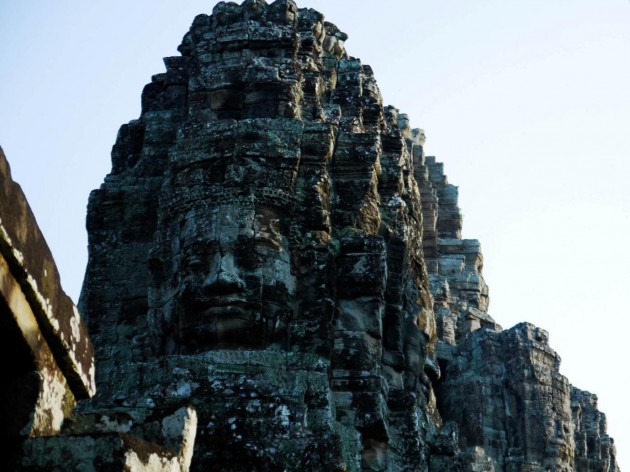 The smiling stone face of the Bodhisattva Avalokiteshvara at Bayon Temple. Photo by: Manesha Pereira
The smiling stone face of the Bodhisattva Avalokiteshvara at Bayon Temple. Photo by: Manesha Pereira
The Final Product
I finally lay down my chisel after close to three hours of carving. A beautifully shaped Romdoul flower stone candle holder, with a small circular yellow lily candle placed in its hole, lies before me. “You okay?” Khet asks quizzingly, looking at my flushed face. “Hard work right?”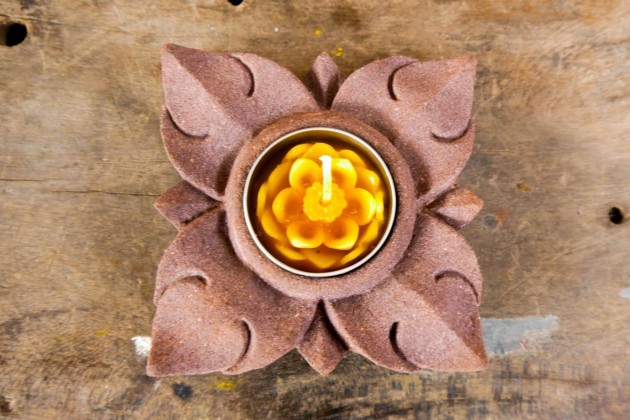 My own personally-carved Romdoul flower candle holder.
My own personally-carved Romdoul flower candle holder.
Indeed. Fragments of stone and dust envelope the surface of the work table, like a mini excavation site. “But you do good, you faster than other tourists,” he adds. I ask him how long it takes for him to carve the same flower from sandstone. “Too fast,” he laughs sheepishly. “An hour and a half.”
For something which took a copious amount of effort and time, it is barely the size of my palm, measuring merely nine by nine centimetres. Yet what follows is an overwhelmingly indescribable feeling – almost surreal – as my fingers close upon the now washed and polished stone flower, tracing every painstakingly carved defined contour, curve and swirl. Then it hits me: I made this.
I leave the workshop carrying my precious homemade memento close, grateful that I have a piece of Cambodia to take home.
If You Go:
Backstreet Academy is a social enterprise which offers unique and authentic activities for tourists hosted by locals. To attend the stone-carving workshop in Siem Reap, Cambodia, book a session through www.backstreetacademy.com.
All pictures taken by author unless otherwise stated.
